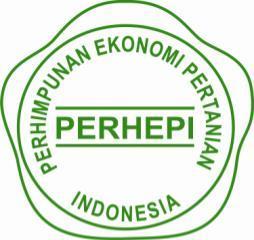Pemanfaatan Trichoderma harzianum pada Kompos dan Fungi Mikoriza arbuskula terhadap Pertumbuhan Rumput Kumpai (Hymenachne amplexicaulis (Rudge) Nees) yang ditanam pada Tanah Bekas Tambang Batu Bara
DOI:
https://doi.org/10.51852/pan0hx47Keywords:
Arbuscular mychorrhizal fungi (AMF), compost, Hymenachne amplexicaulis (Rudge) Ness, post-mining land, Trichoderma harzianum (TH)Abstract
The conversion of agricultural land reduces the available forage cultivation areas, making post-coal mining land a potential alternative. However, its poor soil fertility requires specific treatments to enhance nutrient content. This study evaluates the effect of Trichoderma harzianum (TH) on compost quality and the impact of Arbuscular Mycorrhizal Fungi (AMF) on the growth of Hymenachne amplexicaulis (Rudge) Ness (kumpai grass). The first phase analyzed compost pH, N, P, K, C, and C/N ratio with treatments: P0= (control: 40% cow manure, 35% empty palm bunches, 20% palm fronds, 4% rice bran, 1% urea), P1 (P0 + 2% TH), P2 (P0 + 4% TH), and P3 (P0 + 6% TH). The second phase examined using a factorial design (3×2) of the effects of compost (A0=0 g, A1=12 g, and A2=24 g) and AMF (B0 =0 gr/pot, B1= 20gr/pot). Results showed that TH increased compost C, N, P, and C/N ratio but did not affect pH and K (P>0.05). Compost and AMF interacted to improve Kumpai dry matter yield, while AMF alone increased the number of tillers. Plant height and root dry matter were unaffected. The best compost quality was obtained with 6% TH, while 20 g AMF per pot maximized tiller production. The optimal combination was A2B1 (24 g compost + 20 g AMF per pot), indicating a significant interaction between TH and AMF in enhancing kumpai grass biomass. These findings highlight the potential of integrating compost and AMF to improve post-mining land fertility and forage production.
References
Adriani A, Novra A. 2018. Peningkatan kualitas biourin dari ternak sapi yang mendapat perlakuan Trychoderma harzianum (the increase of biourine quality from cow treated with Trychoderma harzianum). Jurnal Ilmiah Ilmu-Ilmu Peternakan. 20(2): 77–84. https://doi.org/10.22437/jiiip.v20i2.4716.
Alfarezy M, Syafria H, Syafria, Adriani A. 2022. Penggunaan aktivator Stardec terhadap kualitas kompos berbahan dasar pelepah sawit dan feses sapi. Jurnal Peternakan Nusantara. 8(1): 1–8. https://doi.org/10.30997/jpn.v8i1.4926.
Ali A, Zeshan MA, Mehtab M, Khursheed S, Mudasir M, Abid M, Mahdi M, Rauf HA, Ameer S, Younis M, Altaf MT, Tahir A. 2021. A Comprehensive Note on Trichoderma as a Potential Biocontrol Agent Against Soil Borne Fungal Pathogens: a Review. Plant Protection. 5(3): 171–196. https://doi.org/10.33804/pp.005.03.3934.
Ayyandurai M, Therademani M, Raja IY, Balakumbahan R, Kumari SMP, Pushpam AK, Revathy N. 2024. Harnessing Trichoderma Spp. for Sustainable Plant Disease Management: Mechanisms, Metabolites and Application Strategies- a Review. The Journal of Animal and Plant Sciences. 34(2): 304–317. https://doi.org/10.36899/japs.2024.2.0718.
Bachtiar RA, Rifki M, Nurhayat YR, Wulandari S, Kutsiadi RA, Hanifa A, Cahyadi M. 2018. Komposisi unsur hara kompos yang dibuat dengan bantuan agen dekomposer limbah bioetanol pada level yang berbeda. Sains Peternakan. 16(2): 63. https://doi.org/10.20961/sainspet.v16i2.23176.
Basri AHH. 2018. Kajian peranan mikoriza dalam Bidang Pertanian. Agrica Extensia. 12(2): 74–78.
Bina EF, Irawan B, Setiawan WA, Ekowati CN. 2022. Artikel Review: Aplikasi Inokulum Fungi Trichoderma spp. Untuk Pertumbuhan dan Penekan Fitopatogen. JURNAL BIOLOGI PAPUA. 14(2): 158–168. https://doi.org/10.31957/jbp.2377.
[BPS] Badan Pusat Statistik. 2021. Populasi Ternak Besar Kab-Kota (Ekor). https://jambi.bps.go.id/indicator/24/66/2/populasi-ternak-besar-kab-kota.html. Jakarta: BPS.
Chaube SK, Pandey S. 2022. Trichoderma: a Valuable Multipurpose Fungus for Sustainable Agriculture. Malaysian Journal of Sustainable Agricultural. 97–100. https://doi.org/10.26480/mjsa.02.2022.97.100.
Dewi NMEY, Setiyo Y, Nada IM. 2017. Pengaruh bahan tambahan pada kualitas kompos kotoran sapi. Jurnal Beta (Biosistem dan Teknik Pertanian). 5(1): 76–82.
[Dinas ESDM Prov. Jambi] Dinas Energi dan Sumber Daya Mineral Provinsi Jambi. 2019. Data Base Pertambangan Batu Bara Provinsi Jambi. Jambi: Dinas ESDM.
Fariani A, Praramadhan AB, Muslim G, Pratama ANT. 2021. Pola degradasi protein kasar rumput rawa pada kerbau rawa secara in sacco. Prosiding Seminar Nasional Lahan Suboptimal ke-9 Tahun 2021: Sustainable Urban Farming Guna Meningkatkan Kesejahteraan Masyarakat di Era Pandemi. 219–227.
Fidanza MA, Sanford DL, Beyer DM, Aurentz DJ. 2010. Analysis of fresh mushroom compost. HortTechnology. 20(2): 449–453. https://doi.org/10.21273/horttech.20.2.449.
Harahap YM, Syafria H, Devitriano D. 2022. Produktivitas rumput Hymenachne amplexicaulis (rudge) nees berbasis pupuk kompos di tanah ultisol sebagai hijauan pakan. Jurnal Peternakan. 6(2): 144–151.
Hidayat R, Syafria H, Adriani, Lestari WM. n.d. Pemanfaatan EM4 pada kompos dan fma terhadap pertumbuhan rumput kumpai (Hymenachne amplexicaulis (Rudge) ness) Utilization Of EM4 In Compos and FMA toward growth kumpai grass (Hymenachne amplexicaulis (Rudge) ness). Jurnal Peternakan Terapan (PETERPAN). 6(1): 8–14.
Hutabarat NaLR, Lestari WM, Ali NaM, Hidayatulloh NR, Atmaja NBM, Ali NMI, Aisya NEW, Safitri NaR. 2025. The growth and productivity performance of maize (Zea mayz) under water hyacinth (Eichhornia crassipes) Bokashi treatment on Ex-Coal mining soils. Jurnal Ternak 16(1): 59–65. https://doi.org/10.30736/jt.v16i1.249.
Kesumaningwati R. 2018. Penggunaan mol bonggol pisang (Musa paradisiaca) sebagai dekomposer untuk pengomposan tandan kosong kelapa sawit (Utilizing of Banana’s Corm (Musa paradisiaca) microorganisms as oil palm empty fruit bunches decomposer). Ziraa’ah. 40(1): 40–45.
Kusuma ME. 2016. Efektifitas pemberian kompos Trichoderma sp. terhadap pertumbuhan dan hasil rumput setaria (Setaria spachelata). Jurnal Ilmu Hewani Tropika. 5(2): 76–81.
Mahdani YW, Rohmiyati SM, Astuti YTM. 2021. Sifat-sifat tanah pada lahan bekas tambang pengaruhnya terhadap pertumbuhan tanaman kelapa sawit TBM. Journal Agrosita. 5(1): 59–65.
Mashud N, Manaroinsong. 2014. Pemanfaatan bekas tambang batu bara untuk pengembangan sagu. Pemanfaatan Lahan Bekas Tambang Batu Bara Untuk Pengembangan Sagu, 15(1), 56–63. https://doi.org/10.21082/bp.v15n1.2014.56-63.
Nurhalimah, Nurhatika SS, Muhibuddin A. 2013. Eksplorasi mikoriza vesikular arbuskular (MVA) indegenous pada tanah regosol di Pamekasan Madura. Jurnal Sains dan Seni Pomits. 2(1); 2337–3520.
Nurhayati N, Nelwida N. 2014. Quality of agricultural by products fermented by Trichoderma harzianum. Jurnal Agripet. 14(2): 84–88. https://doi.org/10.17969/agripet.v14i2.1869.
Raju Y, Punamalai G. 2025. A review on the overview of Trichoderma - a versatile biocontrol agent and plant growth promotor. Frontiers in Environmental Microbiology. 11(2): 19–25. https://doi.org/10.11648/j.fem.20251102.11.
Renata T, Nowak A, Ozimek E, Jaroszuk-Ściseł J. 2022. Trichoderma: the current status of its application in agriculture for the biocontrol of fungal phytopathogens and stimulation of plant growth. International Journal of Molecular Sciences. 23(4): 2329. https://doi.org/10.3390/ijms23042329.
Prihastuti. 2007. Isolasi dan karakterisasi mikorisa vesicular-arbuskular di lahan kering masam, Lampung Tengah. Berk. Penel. Hayati. 12: 99–106.
Siddiquee S, Shafawati SN, Naher L. 2016. Effective composting of empty fruit bunches using potential Trichoderma strain. Biotechnol Rep (Amst). 13: 1–7.
Sihombing HSW, Armaini, Elfina Y. 2016. Aplikasi biofungisida berbahan aktif Trichoderma sp. dan pupuk kandang sapi terhadap pertumbuhan bibit kakao (Theobroma cacao L.,). JOM Faperta. 3(2): 1–11.
Singh AK, Kumar A, Singh R, Saini R, Maanju S, Leharwan M, Sehgal V, Kumar B, Dixit PS. 2023. Revolutionary Role of Trichoderma in Sustainable Plant Health Management: A review. International Journal of Environment and Climate Change, 13(11), 4203–4217. https://doi.org/10.9734/ijecc/2023/v13i113600.
Soesanto L, Mugiastuti E, Rahayuniati RF, Dewi RS. 2013. Compatibility test of four Trichoderma spp. Isolates and in vitro inhibition ability on several plant pathogens. Journal of Tropical Plant Pests and Diseases. 13(2): 117–123. https://doi.org/10.23960/j.hptt.213117-123.
Sulistiono W, Awaludin MF, Nurhasan R, Aziz AA, Arrasyid MF, Anwar MK. 2022. Pengembangan kualitas lingkungan masyarakat melalui kegiatan kemasyarakatan. Seminar Nasional Pengabdian Masyarakat LPPM UMJ.
Syafria H, Jamarun N. 2018. Pengaruh biourin dan fungi mikoriza arbuskula terhadap hasil hijauan, kecernaan bahan kering dan bahan organik secara in-vitro hijauan lokal kumpai (Hymenachne amplexicaulis (Rudge) Nees.) pada lahan bekas tambang batu bara. Prosiding Seminar Nasional Fakultas Pertanian Universitas Jambi. 978-602-97051-7–1, 249–255.
________. 1996. Pengaruh penggenangan, pemupukan nitrogen dan interval pemotongan terhadap pertumbuhan dan produksi rumput lokal kumpai (Hymenachne amplexicaulis (Rudge) Nees.) [tesisi]. Bogor: IPB.
________. 1998. Pengaruh pemupukan nitrogen dan interval pemotongan terhadap pertumbuhan dan perkembangan rumput lokal kumpai (Hymenachne amplexicaulis (Rudge) Nees.). Laporan Hasil Penelitian Kerja Sama Proyek Pengembangan Sebelas Lembaga Pendidikan Tinggi (ADB Loan). Jambi.
Wahyuni SH. 2018. Potensi Trichoderma viride dalam menekan serangan sclerotium rolfsii pada tanaman kedelai (Glycine max L.). Agrotek Lestari, 5(1): 51–57.
Wearne LJ, Clarkson J, Grice AC, Van Klinken RD, Vitelli JS. 2010. The biology of Australian weeds 56. “Hymenachne amplexicaulis” (Rudge) Nees. Plant Protection Quarterly. 25(4): 146–161. https://www.cabdirect.org/cabdirect/abstract/20113030826.
Downloads
Published
Issue
Section
License
Copyright (c) 2025 Jurnal Agroekoteknologi dan Agribisnis

This work is licensed under a Creative Commons Attribution-NonCommercial 4.0 International License.


1.png)









